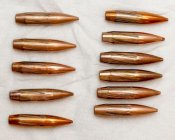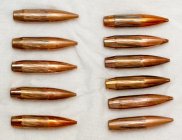I've recently taken to shooting into a water tank to test certain things, and close inspection of the bullets has given me some questions:
Attached photo shows 220gr SMKs fired in .300BLK. The five on the left were shot through an AAC 4140 barrel and the six on the right were through a Noveske stainless barrel. Both barrels are 1:7 twist with 5 lands. (Noveske's is marked "PT" which means it is "button rifled with lands that have a slightly more trapezoidal shape.")
Questions:
[list type=decimal]
[*]In general it appears that even the grooves leave an engraving mark. It's clear on the Noveske bullets as the shorter and more shallow gouge between each of the longer, deeper ones. How is the groove doing this? Both conceptually, and also looking at the barrels, the grooves have the widest diameter, so I don't understand what's producing that inner mark.
[*]Now something weird on the AAC bullets: They have 5 lands clearly engraved but they're mostly missing exactly one of the groove marks. In the first photo I have rotated them all to show where it's missing (although the top bullet shows a bit of the start and end of it). If I rotate them any more (as in the second photo) you can see full-length groove marks similar to those on the Noveske. Can this tell us anything about the internal ballistics of this barrel? Is it just that one of the AAC grooves was cut deeper than the others? Would that be expected to affect accuracy?
[*]Can comparing the engraving give us any insights? E.g., can we conclude from the Noveske's deeper engraving of the grooves that it has a smaller bore cross-section? Could such variation in cross-section cause more friction, obturation, etc.?
[/list]
-

BulletEngraving1.jpg
231.9 KB
· Views: 337
-

BulletEngraving2.jpg
232.4 KB
· Views: 257
Have you lead slugged the barrels for bore / land size . I doubt they are equal .
Measure your fired bullet , but I think the water has skewed those results .
dbooksta I have always wondered about the rifling making a difference in long range shooting, now you have my brain in overdrive! Maybe that's why the first shot out of a clean barrel goes low. The deep grooves in the barrel may put a lot of drag on the bullet till there is enough carbon that allows it to go faster. So would a barrel with shallower grooves be a better way to go.
Joe Salt
This is a total wild ass guess, but perhaps the groove mark is the result of the pressure put on the bullet by the opposing land.
As far as rifling effects on ballistics, they're minimal. The Aberdeen Proving Ground tested it pretty thoroughly and found the difference between unrifled and rifled bullets measurable, but unimportant for their purposes. A very small difference:
"Fortunately, the current results indicate that the effect of rifling grooves and spin rate is not particularly important to the determination of the aerodynamic coefficients and dynamic derivatives."
damoncali said:
This is a total wild *** guess, but perhaps the groove mark is the result of the pressure put on the bullet by the opposing land.
Interesting idea!
One way I might check that is to take out a few of my barrels with even numbers of lands and see if any "engrave" the grooves. Maybe even run some .310 bullets to put a little extra squeeze in there. I'll try to make time to test and report back in this thread.
damoncail Its funny you mention The boys from the Aberdeen Proving grounds they came to Williamsport back in the 80's to find a rifle that would shoot a mile but not maul the snipers. Now this was before anything was going on in the Middle East. I asked one of them what they were going to shoot at a mile? He said Arabs! Think they might have had an Idea what was coming. Anyway my Ithaca Deerslayer II has grooves that are wider but a lot shallower but shoots a slug at 200 yards better than some rifles I've seen.
Joe Salt
We have a picture in our minds of what rifling looks like. In it the bottoms of the grooves are segments of a perfect circle, when in fact, in a button rifled barrel, they take whatever shape the button that made them was, and that may vary from groove to groove. I think that that explains what you are seeing.
dbooksta -
Thanks for sharing...... very interesting !.!.!
Can you give a brief summary of your water tank and some description of your setup and process to shooting into it.
Much appreciated,
Donovan
Since the lands are not cutting out any of the copper jacket but just displacing it, the marks between the lands are where the jacket has "puckered" up and rubbed on the groove. It would be similar to pinching your skin between your fingers.
dmoran said:
Can you give a brief summary of your water tank and some description of your setup and process to shooting into it.
My "test tank" happens to be a backyard swimming pool. For these tests I shot straight into the water at an angle of about 20 degrees. (Key is to keep the angle of incidence greater than 15 degrees to avoid ricocheting off the water's surface -- see
this fascinating series on shooting into water.)
Terminal ballistics appear to be identical to what happens in ballistic gel, but played out over as much as twice the distance (depending on velocity) and of course you don't get a record of the terminal path like you do in gel.
AndyA said:
Since the lands are not cutting out any of the copper jacket but just displacing it, the marks between the lands are where the jacket has "puckered" up and rubbed on the groove. It would be similar to pinching your skin between your fingers.
That makes sense! Accordingly, tighter bores (or overbore bullets) will show "groove marks" and looser bores won't.
So this would give a way to read relative cross-section that is too small to detect measuring slugs. Leaves me wondering what the boundaries (if any) are in terms of cross-section for optimal accuracy?
F-TR obssessed shooting junkie
Here is my thought, what you are seeing is that the bullet is not conforming exactly to the shape of the barrel next to the lands, it is being bent in and creating a bit of a radius (which is why after you've cleaned the heck of your barrel you still get black streaks on a tight patch at the edges of the grooves) the streak on the bullet that shows up between the marks of the lands is where the jacket is actually in solid contact with the steel at the bottom of the groove. It is actually visible to some extent on all of the bullets in the photos
XTR said:
Here is my thought, what you are seeing is that the bullet is not conforming exactly to the shape of the barrel next to the lands, it is being bent in and creating a bit of a radius (which is why after you've cleaned the heck of your barrel you still get black streaks on a tight patch at the edges of the grooves) the streak on the bullet that shows up between the marks of the lands is where the jacket is actually in solid contact with the steel at the bottom of the groove. It is actually visible to some extent on all of the bullets in the photos
Makes even more sense. Also explains why even the first bullet out of a clean barrel can show carbon in the grooves: the gas "seal" isn't really sealed so there's a bit of blow-by in those rifling corners.
Which leads to another question: Why isn't rounded/softly-radiused rifling better in every respect? And by this I mean more extreme than "5R," "PT," etc. I.e., round enough that bullets form complete gas seals, and where there are no corners for fouling to hide or cling. I don't doubt it's been tried before; just wondering what shortcomings it has. I assume it's as easy to make a rifling button or forging blank with soft radii. (Obviously this wouldn't be a practical option for cut rifling.)
If the rifling were rounded, how would the bullet seal the gases, and engrave the jacket to start the spinning process? In addition to imparting spin to the bullet, the barrel must hold the bullet securely and concentrically as it travels through the barrel. I can't see that occurring with rounded rifling.
Seems to work well enough in HK's high end rifles.
damoncali said:
Seems to work well enough in HK's high end rifles.
Would you be referring to their hammer forged barrels?
XTR said:
Here is my thought, what you are seeing is that the bullet is not conforming exactly to the shape of the barrel next to the lands, it is being bent in and creating a bit of a radius (which is why after you've cleaned the heck of your barrel you still get black streaks on a tight patch at the edges of the grooves) the streak on the bullet that shows up between the marks of the lands is where the jacket is actually in solid contact with the steel at the bottom of the groove. It is actually visible to some extent on all of the bullets in the photos
The black streaks you are referring to, is that carbon still left in the barrel after cleaning?
JRS said:
damoncali said:
Seems to work well enough in HK's high end rifles.
Would you be referring to their hammer forged barrels?
If I'm not mistaken, the PSG1 sniper rifle had a sort of radiused polygonal rifling. I've never seen one up close though.
damoncali said:
JRS said:
damoncali said:
Seems to work well enough in HK's high end rifles.
Would you be referring to their hammer forged barrels?
If I'm not mistaken, the PSG1 sniper rifle had a sort of radiused polygonal rifling. I've never seen one up close though.
True

The rifling was in fact polygonal, using the hammer forging process. Hammer forging leaves the same sharp rifling as does the cut/button process. I believe Gary Schneider made/makes aftermarket barrels for them employing his polygonal rifling process. Gary could probably tell us whether the factory barrel used some type of hybrid rifling that might have resulted in a radius on the rifling?
Edit: I found an old article authored by David Tubb, that states, the process used by Gary Schneider results in rifling that has NO sharp edges on the rifling!!!












